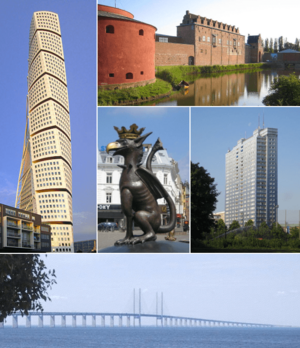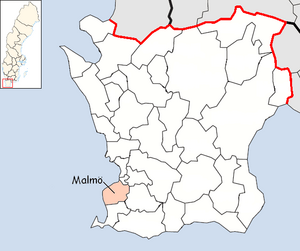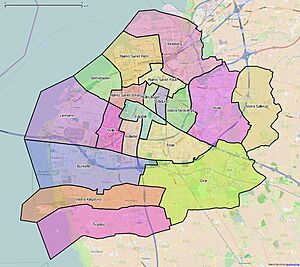Malmö Municipality facts for kids
Quick facts for kids
Malmö Municipality
|
||
|---|---|---|
| Malmö kommun Malmö stad |
||
 |
||
|
||
 |
||
| Country | ||
| County | ||
| Seat | ||
| Area | ||
| • Total | 335.14 km2 (129.40 sq mi) | |
| • Land | 155.56 km2 (60.06 sq mi) | |
| • Water | 179.58 km2 (69.34 sq mi) | |
| Area as of January 1, 2010. | ||
| Population
(June 30, 2012)
|
||
| • Total | 296,169 | |
| • Density | 883.717/km2 (2,288.82/sq mi) | |
| Time zone | UTC+1 (CET) | |
| • Summer (DST) | UTC+2 (CEST) | |
| ISO 3166 code | SE | |
| Province | ||
| Municipal code | 1280 | |
Malmö Municipality (Swedish: Malmö kommun), also known as City of Malmö (Malmö stad), is a municipality in Sweden. It is located in Skåne County, which is the southernmost county in Sweden. The main city in this municipality is Malmö.
Malmö Municipality is a very urban area, meaning it has many cities and towns. It used to be a big industrial area, but now it focuses more on trade, business services, and public services like schools and hospitals. After a period of population decline, the number of people living in Malmö Municipality has been growing since the early 2000s.
Contents
How Malmö Municipality Grew
The area that is now Malmö Municipality started as several smaller areas. In 1863, the Old City of Malmö became one of Sweden's first city municipalities. Over time, more areas joined Malmö. This happened through several mergers in 1911, 1915, 1931, 1935, 1952, 1967, and finally in 1971. These mergers helped Malmö grow into the large municipality it is today.
Exploring Malmö's Geography
Malmö Municipality is in the southwestern part of the Scania province. To its west is the Öresund strait, which separates Sweden from Denmark.
Where Malmö Municipality is Located
Malmö Municipality shares borders with several other municipalities in Sweden:
- To the north: Burlöv Municipality and Staffanstorp Municipality.
- To the east: Svedala Municipality.
- To the south: Vellinge Municipality.
It also has a sea border to the north with Kävlinge Municipality and Lomma Municipality. Across the Öresund strait, Malmö Municipality is connected to Denmark by the Öresund Bridge. It borders Danish municipalities like Dragør Municipality, Tårnby Municipality, and Copenhagen Municipality on the island of Zealand.
Land and Water in Malmö
The land in Malmö Municipality is mostly urban. There used to be many wet meadows (grassy, wet areas) south of the city, but most of these are gone now. The coastline has changed a lot over the years, especially since the early 1900s. For example, a former limestone quarry in Klagshamn is now a peninsula. This area is rich in different plants and animals.
The beaches and coastal areas are mostly urban. Some parts are used for fun activities like recreation, swimming, boating, and hiking. Near Oxie, the landscape is more hilly. These hills are made of sorted sediments and are partly covered with fertile soil, good for farming.
Protecting Nature in Malmö
Malmö Municipality has special areas called nature reserves. These places protect important plants and animals. In 2022, there were three main nature reserves:
- Bunkeflo Strandängar
- Foteviksområdet
- Limhamns kalkbrott (Limhamn limestone quarry)
Bunkeflo Strandängar was the first nature reserve in Malmö, created in 2006. It has over 300 different types of plants, including rare ones like Iris spuria (blue flag) and Artemisia maritima (sea wormwood).
Limhamns kalkbrott (Limhamn limestone quarry) became a reserve in 2010. It is home to about 2,000 different species! You need a guide to visit this area.
The Fotevik area was created in 2011. It's very important for a rare type of bird called the Dunlin (specifically, Calidris alpina schinzii). You can also find rare amphibians like the European green toad and the Natterjack toad here. A rare moth called Morris's wainscot also lives in areas with reeds.
How Malmö is Divided
Malmö Municipality is divided into smaller areas called districts. From 2016, there are 19 districts.
| Bunkeflo | Limhamn | Slottsstaden |
| Eriksfält | Malmö Sankt Johannes | Sofielund |
| Fosie | Malmö Sankt Pauli | Södra Sallerup |
| Husie | Malmö Sankt Petri | Tygelsjö |
| Hyllie | Möllevången | Västra Klagstorp |
| Kirseberg | Oxie | Västra Skrävlinge |
| Kulladal |
Towns and Villages in Malmö Municipality
As of 2015, Malmö Municipality has six larger urban areas (called tätort in Swedish) and six smaller settlements (called småorter).
Here are the main urban areas, listed by how many people lived there in 2018:
| # | Locality | Population |
|---|---|---|
| 1 | Malmö | 316,588 |
| 2 | Bunkeflostrand | 13,561 |
| 3 | Oxie | 13,165 |
| 4 | Tygelsjö | 3,455 |
| 5 | Vintrie | 803 |
| 6 | Skumparp | 253 |
Working with Other Cities (Twin Towns)
Malmö has special agreements with 10 other cities around the world. These are called twin towns or sister cities. They work together on different projects and share ideas. The closest partnerships are with Newcastle (in the UK) and Tallinn (in Estonia).
Here is the full list of Malmö's twin towns and partner cities:
 Vaasa (1940)
Vaasa (1940) Tangshan (1987)
Tangshan (1987) Varna (1987)
Varna (1987) Port Adelaide (1988)
Port Adelaide (1988) Florence (1989)
Florence (1989) Tallinn (1989)
Tallinn (1989) Szczecin (1990)
Szczecin (1990) Stralsund (1991)
Stralsund (1991) Province of Chieti co-operation treaty signed in 2001
Province of Chieti co-operation treaty signed in 2001 Newcastle co-operation treaty signed in 2003
Newcastle co-operation treaty signed in 2003
See also
 In Spanish: Municipio de Malmö para niños
In Spanish: Municipio de Malmö para niños



